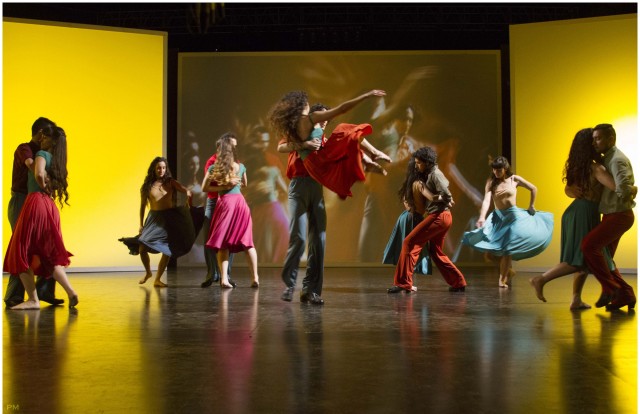
El Ballet Nuevo Arte Nativo de Koki & Pajarín Saavedra performs to “Mi pueblo, mi casa, la soledad” in Carlos Saura’s ARGENTINA (photo © Piqui Mandarine)
ARGENTINA (ZONDA: FOLCLORE ARGENTINO) (Carlos Saura, 2015)
Lincoln Plaza Cinema
1886 Broadway at 63rd St.
Opens Friday, June 17
212-757-2280
www.lincolnplazacinema.com
www.firstrunfeatures.com
 Spanish writer-director Carlo Saura celebrates the history and tradition of Argentinian music and dance in the joyous documentary Argentina. The eighty-four-year-old Saura, whose previous films include Carmen, Tango, El amor brujo, and Flamenco, Flamenco, and production designer Pablo Maestre Galli built stages in a vast, empty barn in La Boca barrio of Buenos Aires City to honor such local and regional art forms as Zamba, Vidala, Chacarera, Malambo, Copla, and Chamamé. Using archival footage, silhouette-creating scrims, mirrors, and live projections, Saura and cinematographer Félix Chango Monti follow a series of set pieces with no narration or explanation, creating a simple and beautiful record of Argentinian music and dance. Among the lovely performances are pianist Horacio Lavandera playing Carlos Guastavino’s “Bailecito,” “Bagualas” featuring Mariana Carrizo, Melania Pérez, and Tomas Lipan, “La Felipe Varela” with Chaqueño Palavecino and Jimena Teruel, “Añoranzas” by Soledad Pastorutti, Metabombo’s “Ritmo de Malambo” with Carlos “Pajarín” Saavedra and Jorge “Koki” Saavedra, and “En el fondo del mal” by Gabo Ferro and Luciana Jury.
Spanish writer-director Carlo Saura celebrates the history and tradition of Argentinian music and dance in the joyous documentary Argentina. The eighty-four-year-old Saura, whose previous films include Carmen, Tango, El amor brujo, and Flamenco, Flamenco, and production designer Pablo Maestre Galli built stages in a vast, empty barn in La Boca barrio of Buenos Aires City to honor such local and regional art forms as Zamba, Vidala, Chacarera, Malambo, Copla, and Chamamé. Using archival footage, silhouette-creating scrims, mirrors, and live projections, Saura and cinematographer Félix Chango Monti follow a series of set pieces with no narration or explanation, creating a simple and beautiful record of Argentinian music and dance. Among the lovely performances are pianist Horacio Lavandera playing Carlos Guastavino’s “Bailecito,” “Bagualas” featuring Mariana Carrizo, Melania Pérez, and Tomas Lipan, “La Felipe Varela” with Chaqueño Palavecino and Jimena Teruel, “Añoranzas” by Soledad Pastorutti, Metabombo’s “Ritmo de Malambo” with Carlos “Pajarín” Saavedra and Jorge “Koki” Saavedra, and “En el fondo del mal” by Gabo Ferro and Luciana Jury.
Marcela Vilariño’s costumes add authenticity to the presentations, which also include tributes to Argentinian legends Mercedes Sosa (“Todo cambia,” in front of young students) and Atahualpa Yupanqui (“Preguntitas sobre Dios”). The choreography is by the Saavedra brothers, whose Ballet Nuevo Arte Nativo de Koki & Pajarín Saavedra dances to “Mi pueblo, mi casa, la soledad,” while Lito Vitale serves as musical coordinator (and performs “La Telesita”). Saura, whose films have been nominated for three Academy Awards for Best Foreign Language Film (in addition to numerous wins and/or nominations at the Venice, Cannes, and Berlin film festivals), occasionally goes behind the scenes, showing dancers warming up and putting on makeup, particularly before “Gato Sachero,” in which women transform into cats. Other highlights include Pedro Aznar’s “Vidala para mi sombra,” Liliana Herrero’s “Luna Tucumana,” Jaime Torres’s “Zamba Alegre,” Juventud Prolongada’s “Endiablado,” and “Volveré siempre a San Juan” and “Póngale por las hileras,” in a happening café. Even the end credits are a treat, displaying some of the colorful preparatory sketches for the sets and costumes.